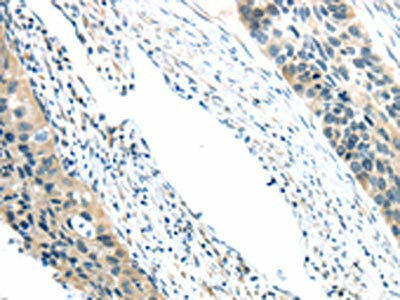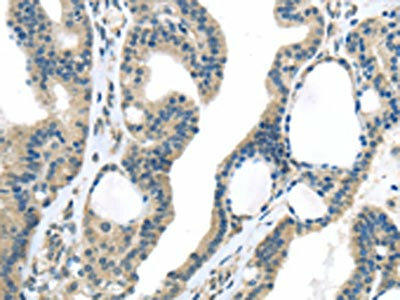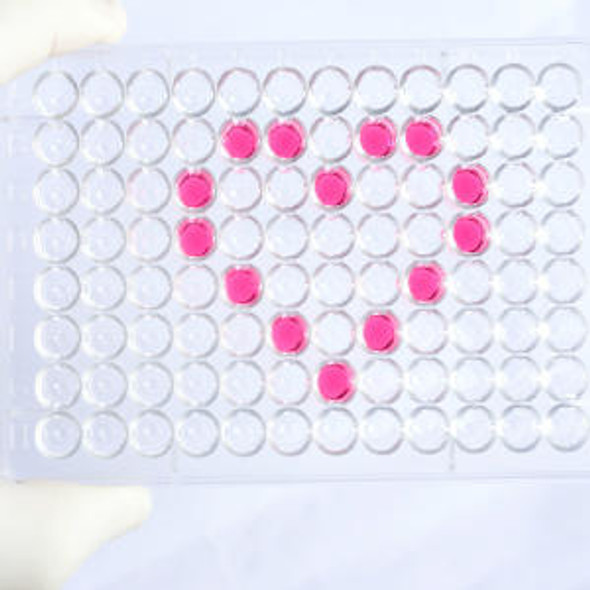Description
| Antibody Name: | VGF Antibody (PACO20853) |
| Antibody SKU: | PACO20853 |
| Size: | 50ul |
| Host Species: | Rabbit |
| Tested Applications: | ELISA, IHC |
| Recommended Dilutions: | ELISA:1:2000-1:5000, IHC:1:25-1:100 |
| Species Reactivity: | Human, Rat |
| Immunogen: | Synthetic peptide of human VGF |
| Form: | Liquid |
| Storage Buffer: | -20°C, pH7.4 PBS, 0.05% NaN3, 40% Glycerol |
| Purification Method: | Antigen affinity purification |
| Clonality: | Polyclonal |
| Isotype: | IgG |
| Conjugate: | Non-conjugated |
 | The image on the left is immunohistochemistry of paraffin-embedded Human esophagus cancer tissue using PACO20853(VGF Antibody) at dilution 1/35, on the right is treated with synthetic peptide. (Original magnification: x200). |
 | The image on the left is immunohistochemistry of paraffin-embedded Human thyroid cancer tissue using PACO20853(VGF Antibody) at dilution 1/35, on the right is treated with synthetic peptide. (Original magnification: x200). |
| Background: | This gene is specifically expressed in a subpopulation of neuroendocrine cells, and is upregulated by nerve growth factor. The structural organization of this gene is similar to that of the rat gene, and both the translated and the untranslated regions show a high degree of sequence similarity to the rat gene. The encoded secretory protein also shares similarities with the secretogranin/chromogranin family, however, its exact function is not known. |
| Synonyms: | VGF nerve growth factor inducible |
| UniProt Protein Function: | VGF: May be involved in the regulation of cell-cell interactions or in synatogenesis during the maturation of the nervous system. |
| UniProt Protein Details: | Protein type:Secreted, signal peptide; Secreted Chromosomal Location of Human Ortholog: 7q22.1 Cellular Component: extracellular space; transport vesicle; cytoplasmic vesicle Molecular Function:neuropeptide hormone activity; growth factor activity Biological Process: response to dietary excess; generation of precursor metabolites and energy; response to cAMP; ovarian follicle development; insulin secretion; sexual reproduction; defense response to bacterium; response to cold; glucose homeostasis; response to insulin stimulus |
| NCBI Summary: | This gene is specifically expressed in a subpopulation of neuroendocrine cells, and is upregulated by nerve growth factor. The structural organization of this gene is similar to that of the rat gene, and both the translated and the untranslated regions show a high degree of sequence similarity to the rat gene. The encoded secretory protein also shares similarities with the secretogranin/chromogranin family, however, its exact function is not known. [provided by RefSeq, Jul 2008] |
| UniProt Code: | O15240 |
| NCBI GenInfo Identifier: | 206729943 |
| NCBI Gene ID: | 7425 |
| NCBI Accession: | O15240.2 |
| UniProt Secondary Accession: | O15240,Q9UDW8, |
| UniProt Related Accession: | O15240 |
| Molecular Weight: | 67,258 Da |
| NCBI Full Name: | Neurosecretory protein VGF |
| NCBI Synonym Full Names: | VGF nerve growth factor inducible |
| NCBI Official Symbol: | VGF |
| NCBI Protein Information: | neurosecretory protein VGF; neuro-endocrine specific protein VGF |
| UniProt Protein Name: | Neurosecretory protein VGF |
| Protein Family: | Neurosecretory protein |
| UniProt Gene Name: | VGF |
| UniProt Entry Name: | VGF_HUMAN |
| Antibodies | ELISA Kits |
| Anti-VGF Antibody (CAB14795) | Human VGF / Nerve Growth Factor Inducible ELISA Kit |
| VGF Antibody (PACO01996) | Human Neurosecretory protein VGF (VGF) ELISA Kit |
| VGF Antibody (PACO05296) |
| Secondary Antibody |
| Anti-HRP Goat Anti-Rabbit IgG (H+L) Antibody (CABS014) |
| Recommended Products |
| Anti-FITC Goat Anti-Rabbit IgG (H+L) Antibody (CABS011) |
| Anti-HRP-conjugated Beta Actin Antibody (CABC028) |






